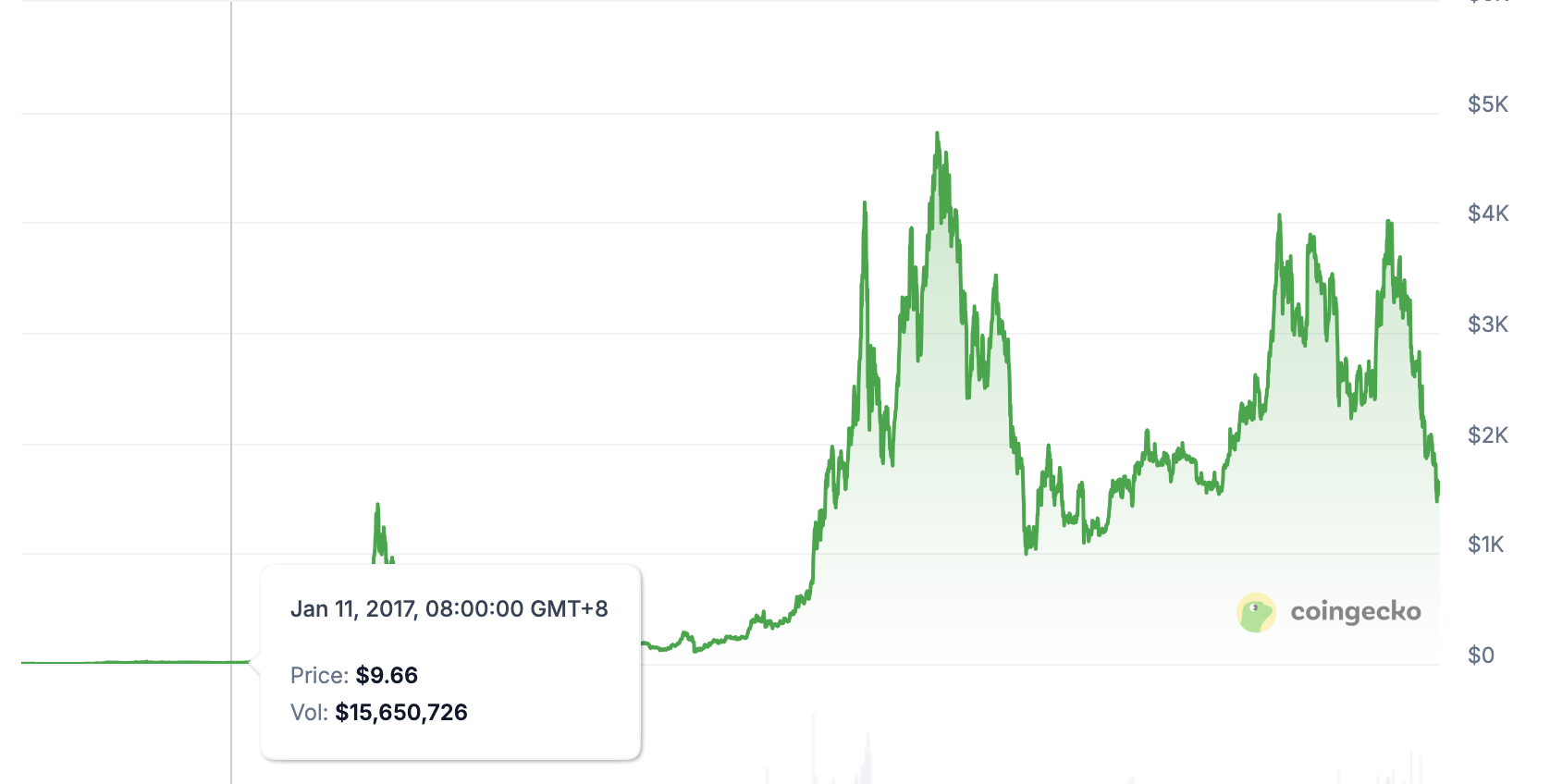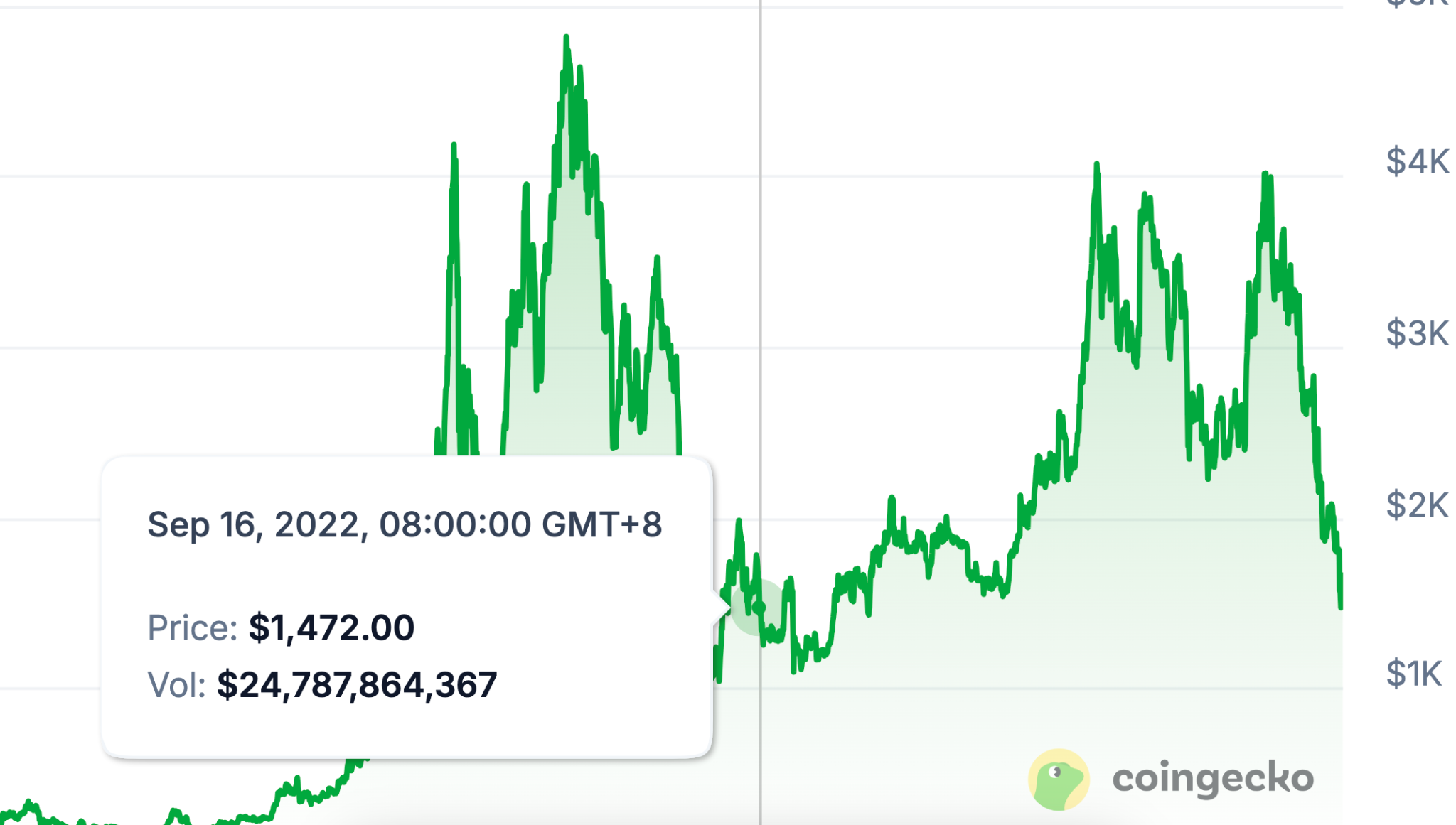One is so big that it is surrounded by fierce rivals, is Ethereum still good?
Author:
ABC Alpha Researcher – Twitter ID @Cyrus_G3
Since Bitcoin broke through the previous high ($69,000) in 2024 and Ethereum is getting farther and farther away from the previous high ($4,800), doubts about Ethereum have been growing louder and louder.
By 2025, Ethereum will fall below $3,000 in February, $2,000 in March, and even $1,500 in April. Many ancient addresses from the ICO era have also begun to clear Ethereum. The leading institutions that once supported Ethereum have also begun to waver.
What the hell is wrong with Ethereum? Is there any hope for Ethereum?
This article will focus on these two issues, starting from the following five aspects, and review the rise and fall of Ethereum, as well as look forward to the possible future of Ethereum.
1. Ethereum's glorious years (2017-2022)
In July 2014, Ethereum launched its ICO
However, since 2014-2016, the price of Ethereum has been below $10, and Ethereum at this stage has the name of blockchain 2.0, and the smart contract technology is also very cool, but Ethereum at this time is useless.

In 2017, the era of rampant ICOs began, and Ethereum began to become very useful, and everyone bought ETH to participate in ICOs. Until January 13, 2018, Ethereum has risen from $10 at the beginning of 2017 to $1,430, reaching a new high for the first time in Ethereum's history.
According to incomplete statistics, from 2017 to early 2018, more than 2,500 tokens used ETH to launch ICOs. At this stage, the biggest value of Ethereum is the issuance of coins, and ETH is not only the most consumed GAS token on the chain, but also the only bargaining chip to participate in the IOC wealth wave.
Although many new public chains such as NEO, QUTM, EOS, TRON and so on have also been born at this stage, the combined market share of other public chains is almost negligible in the ICO and smart contract market monopolized by Ethereum.
At this stage, Ethereum has enjoyed a huge dividend for innovators!
From 2018 to 2019, it is the era of hundreds of chains
Because of the success of Ethereum, countless new public chains have sprung up in the market, in addition to the above mentioned, we will list a few public chains that many people may not be familiar with, such as: GXC, NULS, ELF, Algorand, etc.
Of course, there are also some public chains that are still active at this stage, such as: TON, ADA, Cosmos, Avalanche, of course, the most famous of them is Solana, yes, Solana was not prominent among the new public chains at the time, but a few years later, it became the biggest challenger to Ethereum, which is quite emotional.
Although, at this stage, there are countless new public chains in the market that are trying to challenge Ethereum, Ethereum still absolutely monopolizes the smart contract market. Smart contracts were first created by Ethereum, the era of smart contracts was opened by Vitalk, V God has a huge appeal and influence second only to Satoshi Nakamoto in the global Crypto field, and the Ethereum ecosystem also gathers the world's largest number of smart contract developers and countless native Crypto technology and thought innovators, all of which will be vividly and vividly performed in the coming 2020.
Finally, in 2020, the summer of DEFI that has made countless people dream back, the absolute highlight moment of Ethereum, has finally arrived.
After silent fermentation and continuous exploration from 2018 to 2019, the first batch of Crypto native applications, DEFI Protocol, finally broke out in the Ethereum ecosystem in the summer of 2020.
Compound's miraculous liquidity mining directly detonated the market, and a large amount of ETH was used to mint COMP, skyrocketing TVL and platform coins, opening a wave of liquidity mining
Uniswap, which Vitalik personally invested, opened the era of on-chain DEXs with the minimalist formula of X*Y=K
Yearn.Finance launched a DEFI yield aggregator, and #YFI, which skyrocketed 10,000 times in 30 days, is even more unbeatable
The DAI launched by MakerDAO has led to the birth of the first decentralized stablecoin on Ethereum
Curve's stablecoin DEX, which allows many stablecoins and DEFI tokens to obtain silky liquidity on Ethereum
…….
DEFI Summer has pushed everyone's expectations for Ethereum to a peak, because Ethereum can not only be used to issue coins, but also to build truly valuable decentralized applications, and the decentralized world of the future will be built on Ethereum. Ethereum is eating the world.
Following the DEFI Summer in 2020, in 2021 and 2022, the Ethereum ecosystem has also seen a boom in GameFi, SocialFi, NFT and other booms, with waves of innovation making the Ethereum ecosystem thriving.
On November 10, 2021, Ethereum reached an all-time high of $4,878, and Ethereum's boom reached its peak.
However, as the Ethereum chain carries more and more funds, users, and applications, Ethereum also begins to become more expensive and slower.
The problem of performance scaling has become the biggest obstacle on the road to Ethereum's development.
2. Ethereum's Expansion and Turning Road (POS-Layer 2)
Ethereum's expansion plan has always had two main directions - the transfer of POS mechanism and the development of Layer 2
Vitalik believes that POS is more resource-efficient than POW, and that the POS mechanism can also improve the performance of the Ethereum network and make Ethereum more scalable.
The Layer 2 solution is also the direction of Ethereum network expansion that Vitalik has been promoting, from the initial exploration of state channels (Raiden Network), subnets (Plasma, Sharding) and other directions, to the Rollup solution that has become mainstream in the later stage. and OP-Rollup and ZK-Rollup, which will break out in 2022-2023, have brought hope for Ethereum's expansion.
Whether it was turning to POS or Layer 2, in the Ethereum community at the time, it was considered the right choice to make Ethereum continue to be great and prosperous.
Although the transfer to the POS mechanism has attracted the dissatisfaction of a large number of miners, Ethereum still officially switched to the POS mechanism on September 15, 2022. Ethereum's POW era is over, miners are gone, and the only thing Ethereum can rely on in the future is developers and Layer 2.
However, is Layer 2 really Ethereum's savior?
After the development from 2022 to 2024, many Layer 2s of Ethereum have been launched one after another, and we are talking about the names on them: Arbitrum, Optimism, zkSync, StarkNet, Mantle, BASE, Blast, Scroll, Linea, Polygon zkEVM, etc.
However, after each Layer 2 is launched, it does not bring more gains to Ethereum, but is constantly sucking blood and eating Ethereum, every Layer 2 is engaged in TVL competitions, and is engaged in cookie-cutter Dapps, and few Layer 2s have really run out of applications that the Ethereum mainnet does not have.
In the end, Ethereum became the true Zhou Tianzi, and the Layer 2 became its own vassal states, not only constantly eating the market of Ethereum, but also having the ambition to replace the other.
Later, a number of original Ethereum-native applications such as Uniswap began to build their own Layer 2, and even replaced ETH as GAS with their own tokens, which was already a complete betrayal.
Ethereum has cultivated a large number of Layer 2s, and almost all of them have eventually become competitors for mainnet liquidity and developers.
The expansion of Layer 2 has been falsified.
Looking back, Ethereum's abandonment of POW is also almost an act of self-severing.
With the loss of miners, ETH tokens have lost their basic manufacturing costs and the most basic price-carrying mechanism.
Assuming that Ethereum did not turn to POS at the beginning, but continued to develop Layer 2 in the POW mechanism, even if the development of Layer 2 is unfavorable, but because there are miners and a large amount of computing power and electricity are constantly invested in Ethereum, the price bearing mechanism of ETH is still effective, then, the price of Ethereum will most likely not be what it is today, at least not as miserable as it is today.
The figure below is the price of Ethereum when it was converted to POS, about $1,500, and today three years later, Ethereum is still about $1,500.
It all seemed so absurd and predestined.

3. Ethereum's innovator dilemma (chased and blocked by public chains such as Solana)
Regardless of whether the switch to POS and Layer 2 is a success or failure, no one can deny that Ethereum has always been a leader in Crypto innovation.
Before 2022, all innovations in the Crypto space were born and developed from Ethereum, and then copied by other chains.
Ethereum has DeFi, and other chains are also engaged in DeFi; Ethereum has GameFI, and other chains are also engaged in GameFI; Ethereum has NFTs, and other chains also want to engage in NFTs.
Ethereum is always innovating, and other chains are always imitating.
However, innovators often fall into the innovator's dilemma.
The "innovator's dilemma" is often when industry leaders focus on optimizing existing technologies and meeting current user needs while ignoring emerging disruptive technologies or market trends, ultimately being overtaken by more agile competitors.
AFTER 2020, IN ORDER TO OPTIMIZE THE PERFORMANCE OF ETHEREUM AND MEET THE NEEDS OF EXISTING DEFI AND OTHER USERS, ETHEREUM HAS BEEN LOOKING FOR A WAY TO EXPAND, WHICH CAN BE SUMMED UP AS MAKING ETH FASTER AND CHEAPER. Core developers are basically betting on the two routes of switching to the POS mechanism and supporting the development of Layer 2.
From the perspective of Ethereum's development, there is nothing wrong with this, or even the only path to take. However, this is the inevitable dilemma of innovators.
Since, users need a faster and cheaper blockchain, why not BSC, why not Tron, why not Solana?
What does the market need for Crypto to develop into 2020? What do users need? How to play, the top players have already figured it out. It's nothing more than issuing assets, trading assets, and finding scenes for assets, and then, so that everyone can play faster and more conveniently.
Now, Ethereum is busy scaling, and it's slow and expensive, so there's a chance for a fast and cheap blockchain.
As a result, TRON seized the market for stablecoins.
BSC and BASE have closed the loop around their own exchange ecological barriers, and the logic of project issuance and trading has also closed.
The most terrifying thing is Solana, the Foundation himself ended, relying on the simple and crude Meme Dafa, uniting the forces of all parties, and continuing to create the myth of wealth, Sol has become the touchstone that everyone desires in the Meme frenzy.
Ethereum is being overtaken by its competitors.
Ethereum has always been the innovator and leader of the underlying public chain technology, whether it is the initial smart contract technology or the later various decentralized applications, it is a product of the times.
However, everything in the public chain is open source, and there are no secrets to speak of.
If you innovate a technology today, I can use it tomorrow.
You have a new way to play today, and I can imitate it right away.
Ethereum's continued glory from 2017 to 2022 comes from its leading technology and continuous innovation in ecological gameplay. However, after 2022, after Ethereum's core developers focus on the underlying research and development such as expanding performance, Ethereum's innovation in applications and gameplay will begin to slow down.
Because, if Ethereum does not innovate, it will fall behind, which is the fate of open source public chains.
However, is this Ethereum's fault?
Not.
There's nothing wrong with Ethereum, it's not wrong to expand performance, engage in underlying R&D, and provide better infrastructure. This is the dilemma that innovators must face when they reach a certain point of development.
In addition, the weakness of Ethereum also highlights a more serious problem, that is, the crypto industry is really underdeveloped.
Fourth, the weakness of Ethereum is the stunting of the entire industry
In addition to Bitcoin, Ethereum is arguably the biggest innovation in the crypto space.
But why is Ethereum suddenly not working?
In addition to the fact that the low-level R&D is overtaken by more flexible competitors, is there a deeper reason?
I think there is. That is, the Crypto industry still has not found a truly healthy development paradigm, or in other words, in addition to issuing assets, in addition to engaging in asset speculation, does Crypto have more application value?
Until this answer is found, the crypto industry is typically stunted.
What is stunting?
You see, in this round of cycle, in addition to BTC, only Meme and wealth effect remain, and many VC-backed projects of various types are not paid.
Why doesn't anyone pay? Because, as we all know, these projects are just storytelling and have no real value.
In this case, it is better to buy the safest BTC, and then play the simplest and crudest meme.
Therefore, until the Crypto industry develops a truly valuable application, there is a high probability that the current model will still circulate, and if one day, even the meme loses the wealth effect, then there will really be only an endless bear market left.
Therefore, I said, instead of lamenting the weakness and decline of Ethereum, the real concern is, where is the path of Crypto?
Fifth, in the future, it may be difficult for Ethereum to dominate alone
So, what does the future hold for Ethereum?
As we mentioned earlier, the smart contract market opened up by Ethereum and many models of Crypto can be simply copied by other competing chains.
THE ONLY BARRIERS THAT ETHEREUM STILL HAS ARE THE FUNDS DEPOSITED ON THE ETHEREUM MAINNET AND THE DEFI ECOSYSTEM THAT HAS FORMED A CLOSED LOOP. THESE DEFI PROTOCOLS, FROM LENDING, TRADING, STABLECOINS, ON-CHAIN LEVERAGE, ETC., HAVE FORMED A TIGHTLY KNIT AND ORGANICALLY COMBINED DEFI ECOSYSTEM. ALL ASSETS THAT ENTER THE CHAIN, WHEN SEEKING LIQUIDITY, ETHEREUM'S DEFI IS AN UNAVOIDABLE LINK.
Therefore, many people say that RWA may be an opportunity for Ethereum, and I strongly agree. However, RWA is a long road, and whether Ethereum can continue to create more and more updated on-chain gameplay is still one of the most effective breakthroughs.
However, Ethereum did lose its monopoly position.
In any case, Ethereum's competitors have really developed and formed their own barriers.
Ethereum's years of expansion have not improved performance, Ethereum is still very slow and expensive, and applications that require high performance will still not choose Ethereum in the future, but new public chains such as Solana, TON, BSC, Tron and even SUI.
So, will Ethereum lose its position as the second largest in the millennium? Will the title of the king of public chains be replaced by other chains?
I don't dare to give an answer directly, however, we can do simple reasoning:
If Ethereum's only remaining DEFI advantage is also taken away by new public chains such as Solana.
If so, Ethereum has been slow to improve its performance.
If so, Ethereum's ecological innovation is still slow and the market is half a beat.
If, the developers of Ethereum are gradually leaving.
So, in the pattern of wolves and tigers, how will Ethereum, which is expensive, slow and lacking in innovation, fall?
As a former Ethereum Maximalist, I still expect Ethereum to continue to innovate, and Vitalik to continue to lead the Ethereum developer community and continue to launch more innovative applications and development paradigms, because only continuous innovation is the only barrier to Ethereum.
summary
This article reviews Ethereum's eight-year history from 2017 to the present. Ethereum represents the second possibility of blockchain technology, which is the biggest innovation after Bitcoin. The rise of Ethereum stems from ICO, that is, the use of smart contracts to issue coins for financing, which is the earliest application scenario of ETH. From 2020 to 2021, DEFI, GameFi, SocialFi, NFT, etc. have pushed Ethereum's smart contract application scenarios to a peak. At the same time, the price of ETH has also reached its peak.
However, from 2022 to 2023, Ethereum's focus will be on shifting to POS and expanding the underlying R&D direction of Layer 2, and the Ethereum ecosystem lacks decent application innovation or model innovation for the market and community. This is the core reason why Ethereum and its eco-related tokens are so sluggish and weak in this cycle.
When we ask about the future of Ethereum, we are actually asking what the future of the Crypto application market is, and whether Ethereum is prosperous or not, to a certain extent, reflects the development of Crypto. After all, we can't just have Bitcoin and Meme in our industry.
Bless Ethereum, bless Crypto. Even if one day, Ethereum will no longer dominate the smart contract market, but the technology and paradigm innovation of the Ethereum ecosystem are still worth all of us looking forward to.
